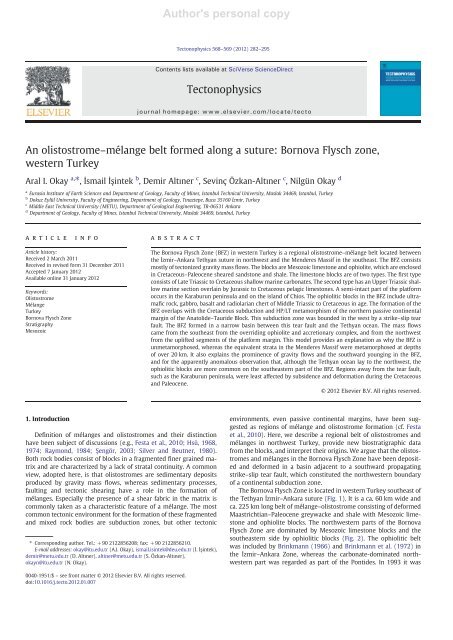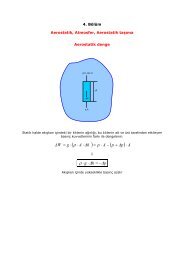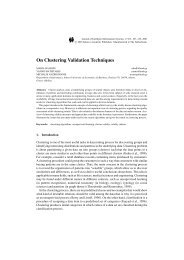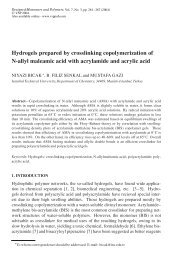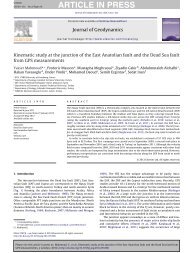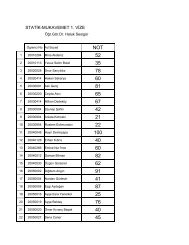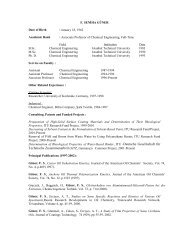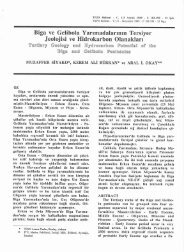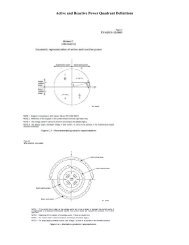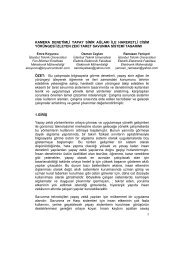Author's personal copy - İstanbul Teknik Üniversitesi
Author's personal copy - İstanbul Teknik Üniversitesi
Author's personal copy - İstanbul Teknik Üniversitesi
Create successful ePaper yourself
Turn your PDF publications into a flip-book with our unique Google optimized e-Paper software.
<strong>Author's</strong> <strong>personal</strong> <strong>copy</strong><br />
An olistostrome–mélange belt formed along a suture: Bornova Flysch zone,<br />
western Turkey<br />
Aral I. Okay a, ⁎, İsmail İşintek b , Demir Altıner c , Sevinç Özkan-Altıner c , Nilgün Okay d<br />
a<br />
Eurasia Institute of Earth Sciences and Department of Geology, Faculty of Mines, Istanbul Technical University, Maslak 34469, Istanbul, Turkey<br />
b<br />
Dokuz Eylül University, Faculty of Engineering, Department of Geology, Tınaztepe, Buca 35160 İzmir, Turkey<br />
c<br />
Middle East Technical University (METU), Department of Geological Engineering, TR-06531 Ankara<br />
d<br />
Department of Geology, Faculty of Mines, Istanbul Technical University, Maslak 34469, Istanbul, Turkey<br />
article info<br />
Article history:<br />
Received 2 March 2011<br />
Received in revised form 31 December 2011<br />
Accepted 7 January 2012<br />
Available online 31 January 2012<br />
Keywords:<br />
Olistostrome<br />
Mélange<br />
Turkey<br />
Bornova Flysch Zone<br />
Stratigraphy<br />
Mesozoic<br />
1. Introduction<br />
abstract<br />
Definition of mélanges and olistostromes and their distinction<br />
have been subject of discussions (e.g., Festa et al., 2010; Hsü, 1968,<br />
1974; Raymond, 1984; Şengör, 2003; Silver and Beutner, 1980).<br />
Both rock bodies consist of blocks in a fragmented finer grained matrix<br />
and are characterized by a lack of stratal continuity. A common<br />
view, adopted here, is that olistostromes are sedimentary deposits<br />
produced by gravity mass flows, whereas sedimentary processes,<br />
faulting and tectonic shearing have a role in the formation of<br />
mélanges. Especially the presence of a shear fabric in the matrix is<br />
commonly taken as a characteristic feature of a mélange. The most<br />
common tectonic environment for the formation of these fragmented<br />
and mixed rock bodies are subduction zones, but other tectonic<br />
⁎ Corresponding author. Tel.: +90 2122856208; fax: +90 2122856210.<br />
E-mail addresses: okay@itu.edu.tr (A.I. Okay), ismail.isintek@deu.edu.tr (İ. İşintek),<br />
demir@metu.edu.tr (D. Altıner), altiner@metu.edu.tr (S. Özkan-Altıner),<br />
okayn@itu.edu.tr (N. Okay).<br />
0040-1951/$ – see front matter © 2012 Elsevier B.V. All rights reserved.<br />
doi:10.1016/j.tecto.2012.01.007<br />
Tectonophysics 568–569 (2012) 282–295<br />
Contents lists available at SciVerse ScienceDirect<br />
Tectonophysics<br />
journal homepage: www.elsevier.com/locate/tecto<br />
The Bornova Flysch Zone (BFZ) in western Turkey is a regional olistostrome–mélange belt located between<br />
the İzmir–Ankara Tethyan suture in northwest and the Menderes Massif in the southeast. The BFZ consists<br />
mostly of tectonized gravity mass flows. The blocks are Mesozoic limestone and ophiolite, which are enclosed<br />
in Cretaceous–Paleocene sheared sandstone and shale. The limestone blocks are of two types. The first type<br />
consists of Late Triassic to Cretaceous shallow marine carbonates. The second type has an Upper Triassic shallow<br />
marine section overlain by Jurassic to Cretaceous pelagic limestones. A semi-intact part of the platform<br />
occurs in the Karaburun peninsula and on the island of Chios. The ophiolitic blocks in the BFZ include ultramafic<br />
rock, gabbro, basalt and radiolarian chert of Middle Triassic to Cretaceous in age. The formation of the<br />
BFZ overlaps with the Cretaceous subduction and HP/LT metamorphism of the northern passive continental<br />
margin of the Anatolide–Tauride Block. This subduction zone was bounded in the west by a strike–slip tear<br />
fault. The BFZ formed in a narrow basin between this tear fault and the Tethyan ocean. The mass flows<br />
came from the southeast from the overriding ophiolite and accretionary complex, and from the northwest<br />
from the uplifted segments of the platform margin. This model provides an explanation as why the BFZ is<br />
unmetamorphosed, whereas the equivalent strata in the Menderes Massif were metamorphosed at depths<br />
of over 20 km. It also explains the prominence of gravity flows and the southward younging in the BFZ,<br />
and for the apparently anomalous observation that, although the Tethyan ocean lay to the northwest, the<br />
ophiolitic blocks are more common on the southeastern part of the BFZ. Regions away from the tear fault,<br />
such as the Karaburun peninsula, were least affected by subsidence and deformation during the Cretaceous<br />
and Paleocene.<br />
© 2012 Elsevier B.V. All rights reserved.<br />
environments, even passive continental margins, have been suggested<br />
as regions of mélange and olistostrome formation (cf. Festa<br />
et al., 2010). Here, we describe a regional belt of olistostromes and<br />
mélanges in northwest Turkey, provide new biostratigraphic data<br />
from the blocks, and interpret their origins. We argue that the olistostromes<br />
and mélanges in the Bornova Flysch Zone have been deposited<br />
and deformed in a basin adjacent to a southward propagating<br />
strike–slip tear fault, which constituted the northwestern boundary<br />
of a continental subduction zone.<br />
The Bornova Flysch Zone is located in western Turkey southeast of<br />
the Tethyan İzmir–Ankara suture (Fig. 1). It is a ca. 60 km wide and<br />
ca. 225 km long belt of mélange–olistostrome consisting of deformed<br />
Maastrichtian–Paleocene greywacke and shale with Mesozoic limestone<br />
and ophiolite blocks. The northwestern parts of the Bornova<br />
Flysch Zone are dominated by Mesozoic limestone blocks and the<br />
southeastern side by ophiolitic blocks (Fig. 2). The ophiolitic belt<br />
was included by Brinkmann (1966) and Brinkmann et al. (1972) in<br />
the İzmir–Ankara Zone, whereas the carbonate-dominated northwestern<br />
part was regarded as part of the Pontides. In 1993 it was
shown that this sedimentary belt extending from Balıkesir southwest<br />
to the Karaburun Peninsula, attributed previously to the<br />
Pontides (e.g., Akyürek and Soysal, 1981; Brinkmann, 1966, 1972;<br />
Brinkmann et al., 1970; Ketin, 1966; Şengör and Yılmaz, 1981), contains<br />
typical Tauride Mesozoic sequences, and the sedimentary belt<br />
along with the ophiolitic zone was named as the Bornova Flysch<br />
Zone (Okay and Siyako, 1993; Okay et al., 1996; Moix et al., 2008).<br />
In particular the Tauride sequences are characterized by carbonate<br />
deposition in the Middle Triassic to Late Cretaceous interval, whereas<br />
the Sakarya Zone of the Pontides has a strongly deformed Upper<br />
Triassic volcano-sedimentary basement unconformably overlain by<br />
Lower Jurassic continental clastic rocks. The extensive and coherent<br />
Mesozoic sequences on the Karaburun Peninsula and on the adjacent<br />
island of Chios have also Tauride affinities. The Bornova Flysch Zone<br />
forms a peculiar mélange–olistostrome belt between the İzmir–<br />
Ankara suture and the Menderes Massif, which shows Eocene regional<br />
metamorphism (Fig. 2).<br />
2. The matrix of the Bornova Flysch Zone<br />
In the Bornova Flysch Zone blocks of various sizes and lithologies<br />
are surrounded by a clastic matrix of sandstone and shale. On the<br />
mesoscopic scale the matrix ranges from essentially undeformed to<br />
a crude foliation induced by gravitational flow (Fig. 3A) to tectonically<br />
sheared sandstones and shales with a penetrative scaly fabric<br />
(Fig. 3B). However, even in apparently undeformed matrix, the bedding<br />
in the sandstones cannot be traced along or across strike for<br />
more than 10 m; shearing has destroyed most signs of the bedding.<br />
<strong>Author's</strong> <strong>personal</strong> <strong>copy</strong><br />
A.I. Okay et al. / Tectonophysics 568–569 (2012) 282–295<br />
Fig. 1. Tectonic map of the Aegean region showing the setting of the Bornova Flysch Zone.<br />
The orientation of the fabric (minor faults, shear zones, fracture<br />
cleavage, cleavage, orientation of the blocks, etc.) is variable within<br />
an outcrop and between outcrops, and no attempt was made to systematically<br />
measure the orientation of the fabric elements. Some of<br />
the fabric was produced during the gravitational flow, especially at<br />
the base of the olistostromes (Fig. 3A and C). However, shearing of<br />
bedded sandstones with no evidence of gravitational flow, indicates<br />
semi-brittle post-depositional deformation. In many outcrops the<br />
superposition of sedimentary and tectonic processes makes the distinction<br />
between olistostromes and mélanges highly problematic.<br />
The Bornova Flysch Zone consists of mélanges with no evidence for<br />
sedimentary processes in their genesis, olistostromes, and tectonized<br />
olistostromes.<br />
The sandstones in the Bornova Flysch Zone are medium to<br />
thickly bedded, commonly laminated greywackes with a greenish<br />
gray, black color in fresh outcrops; they are intercalated with<br />
greenish gray laminated shales. In weathered outcrops the sandstones<br />
and shales have a typical brownish yellow color. There are<br />
no paleontological ages from the sandstone-shale matrix of the<br />
Bornova Flysch Zone. However, some parts of the Bornova Flysch<br />
Zone, especially in the İzmir–Manisa region, include calcareous<br />
shales with thin pelagic limestone intercalations. These yielded<br />
pelagic foraminifera of Middle-Late Maastrichtian–Danian (Kocaçay<br />
region, locality 1 in Fig. 2, Erdoğan, 1990a; İşintek et al., 2007) and<br />
Middle-Late Maastrichtian ages (Kocaçay and Spil Dağı regions,<br />
localities1and6inFig. 2, Erdoğan, 1990a; İşintek et al., 2007) and<br />
nannofossils of Early Paleocene age (Işıklar, locality 4 in Fig. 2, Özer<br />
and İrtem, 1982).<br />
283
The youngest blocks in the Bornova Flysch Zone are usually<br />
Turonian in the northeast and Campanian in the southwest. However,<br />
in one locality close to İzmir (Kocaçay, locality 1 in Figs. 2 and 4),<br />
Paleocene shallow marine limestone clasts occur in a channel fill conglomerate<br />
(Erdoğan, 1990a; İşintek et al., 2007; Konuk, 1977). These<br />
are 1 to 20 m across, grey, biohermal limestones with abundant<br />
corals, sponges, red algae, dasycladea algae and foraminifera. Foraminifera<br />
and algae from twelve samples out of ten blocks give a Middle<br />
to Late Paleocene age based on Lockhartia? sp., Miscellanea sp.,<br />
Cymopolia mayaense, Broeckella belgica, Neomeris sp., Oreoporella cf.<br />
malaviae, Acroporella?chiapasis, Zettelina radoicicae. The other clasts<br />
<strong>Author's</strong> <strong>personal</strong> <strong>copy</strong><br />
284 A.I. Okay et al. / Tectonophysics 568–569 (2012) 282–295<br />
Fig. 2. Geological map of the Bornova Flysch Zone (compiled from Konak, 2002; Konak and Şenel, 2002). The numbers refer to the stratigraphic sections in Figs. 4 and 5.<br />
of similar size as the limestone clasts in the conglomerate are phyllite,<br />
amphibolite, quartz, red and green chert, quartzite and sandstone<br />
(İşintek et al., 2007; Konuk, 1977).<br />
An upper limit to the age of the matrix, as well as to the penetrative<br />
semi-brittle deformation of the Bornova Flysch Zone is given by<br />
the undeformed Lower Eocene (Cuisian) shallow marine limestones,<br />
which lie unconformably over the matrix and blocks of the Bornova<br />
Flysch Zone northeast of Akhisar (Fig. 2, Akdeniz, 1980). Hence paleontological<br />
data constrain the age of deposition and deformation of<br />
the clastic matrix to Maastrichtian–Paleocene. The stratigraphic base<br />
of the flysch is not observed in the main body of the Bornova Flysch
Zone, only in the Karaburun Peninsula Maastrichtian siliciclastic turbidites<br />
lie stratigraphically on Campanian to Maastrichtian pelagic<br />
limestones (see below).<br />
3. Blocks in the Bornova Flysch Zone<br />
The clasts in the Bornova Flysch Zone range from grains to blocks<br />
measuring several kilometers or more. There is evidence in the field<br />
that the smaller clasts, up to a several meters in size, are sedimentary.<br />
They occur as angular clasts in a sandy silty matrix in very poorly<br />
sorted mass flows (Fig. 3C). The observed thickness of the mass<br />
flows ranges from a few meters to tens of meters. For larger blocks,<br />
the contacts between the block and the sandy matrix are generally<br />
sheared; this is probably due to post-depositional deformation,<br />
which was focused along such contacts (Fig. 3D). Although there are<br />
sandstone blocks, derived from the fragmentation of the competent<br />
sandstone beds, most blocks in the Bornova Flysch Zone are exotic,<br />
and are essentially of two types; limestone and ophiolite; these<br />
types are generally not mixed; the limestone blocks are dominant in<br />
the northwest and the ophiolitic blocks in the southeast. The age of<br />
the blocks range from Middle Triassic to Late Cretaceous, and are<br />
older than the matrix.<br />
3.1. Limestone blocks<br />
By far the most common clasts in the Bornova Flysch Zone are<br />
Mesozoic limestones, which range in size from a few centimeters to<br />
several tens of kilometers. In the kilometer-size blocks, it is difficult<br />
to ascertain whether one is dealing with a single block or several juxtaposed<br />
blocks. Detailed biostratigraphic studies have been carried<br />
out in a large number of limestone blocks (Erdoğan, 1990a; İşintek<br />
et al., 2007; Okay and Altıner, 2007; Okay and Siyako, 1993; Poisson<br />
and Şahinci, 1988; Şahinci, 1976). Their common stratigraphic features<br />
are: a) a Late Triassic to Cretaceous age range, b) Late Triassic<br />
is represented by thickly bedded to massive shallow marine limestones.<br />
Volumetrically the Upper Triassic limestones make up more<br />
than 80% of the carbonate blocks, c) Cretaceous red pelagic<br />
<strong>Author's</strong> <strong>personal</strong> <strong>copy</strong><br />
A.I. Okay et al. / Tectonophysics 568–569 (2012) 282–295<br />
Fig. 3. Field photos of the Bornova Flysch Zone. A. crude foliation in the debris flow induced by gravitational flow. B. Tectonically deformed sandstone-shale matrix with a scaly<br />
fabric. C. Olistostrome horizons dipping steeply to the left. D. A block more than 10-m-across in the olistostromes.<br />
limestones lie unconformably over older carbonates and commonly<br />
on the Triassic limestones. Within this common framework the blocks<br />
can be divided into two types, called here as the platform and<br />
platform-margin (Figs. 4 and 5).<br />
3.1.1. Platform-type limestone blocks<br />
In the platform-type blocks, the shallow marine carbonate deposition<br />
continues from the Triassic into the Cretaceous with gaps in<br />
the stratigraphic sequence. These blocks are restricted to the İzmir–<br />
Manisa region close to the Karaburun peninsula and east of Akhisar<br />
(localities 1, 3, 4, 5 and 6 in Fig. 2, for the geographic coordinates of<br />
the measured sections see Table 1 and for characteristic fossil taxa<br />
Fig. 6). The youngest ages from the platform carbonates of the<br />
platform-type blocks are Cenomanian–Turonian in the Naldöken<br />
and Kemalpaşa areas (loc. 3 and 5 in Fig. 2) and Turonian–Coniacian<br />
in the Işıklar area (loc. 4, Fig. 4, Özer and İrtem, 1982; Erdoğan,<br />
1990a; İşintek et al., 2007). Pelagic red marls and micritic limestones<br />
of Late Cretaceous age lie unconformably over Jurassic–Lower Cretaceous<br />
limestones or directly over the Triassic carbonates. The base of<br />
the red pelagic limestones is Coniacian (?)–Early Campanian in the<br />
platform-type blocks and the youngest ages are Early Maastrichtian<br />
(Poisson and Şahinci, 1988; Erdoğan, 1990a; Figs. 4 and 6).<br />
3.1.2. Platform-margin type limestone blocks<br />
In the platform-margin-type blocks the Jurassic–Lower Cretaceous<br />
is characterized by a condensed pelagic marine sequence of pelagic<br />
limestone and radiolarian chert with a total thickness of less than<br />
50 m (Fig. 5). They are known only from north of Manisa. The condensed<br />
series usually starts with Middle or Upper Jurassic pelagic<br />
limestones (Fig. 6), which rest on the Upper Triassic shallow marine<br />
carbonates. In the Urbut section, the Jurassic–Lower Cretaceous sequence<br />
is only 19 meters thick but includes Tithonian, Berriasian,<br />
Valanginian and Albian stages as determined by the foraminifera<br />
fauna (Fig. 5, Okay and Altıner, 2007). The absence of some intervening<br />
Lower Cretaceous stages (e.g., Hauterivian, Barremian and Aptian)<br />
could represent a real gap or could be due to lack of sampling.<br />
285
The Triassic–Lower Cretaceous carbonates are unconformably<br />
overlain by red pelagic limestones. In the Urbut section, Turonian pelagic<br />
limestones contain several meters large Upper Triassic limestone<br />
olistoliths, showing that the disintegration of the carbonate<br />
depositional system started already in the Turonian in the northeast,<br />
whereas platform carbonate deposition was continuing at this time<br />
in the southwest (Okay and Altıner, 2007). In the platform-margintype<br />
blocks, the age of the red pelagic limestones is also older<br />
(Aptian-Cenomanian to Turonian, Fig. 6) than that in the platformtype<br />
blocks (Coniacian-Maastrichtian) again indicating a general<br />
diachronous collapse of the carbonate depositional system with<br />
younging towards the southwest. This also implies that the age of<br />
the flysch matrix youngs from northeast to southwest.<br />
3.2. Ophiolite and radiolarian chert blocks<br />
The ophiolitic blocks in the Bornova Flysch Zone include partially<br />
or totally serpentinitized peridotite, gabbro, diabase and basalt. They<br />
range in size from a few meters to several kilometers. The proportion<br />
of the ophiolitic blocks increases southeastwards at the expense of<br />
limestone blocks, and in Sındırgı region the Bornova Flysch Zone<br />
consist in places of an ophiolitic mélange (Tekin and Göncüoğlu,<br />
2007, 2009; Uz, 1990).<br />
Red radiolarian ribbon cherts, often intercalated with mudstones<br />
and shales, and associated with basalts are common in the southeastern<br />
<strong>Author's</strong> <strong>personal</strong> <strong>copy</strong><br />
286 A.I. Okay et al. / Tectonophysics 568–569 (2012) 282–295<br />
Fig. 4. Stratigraphy of the Karaburun peninsula and platform-type blocks from the Bornova Flysch Zone. Data sources: Karaburun (Erdoğan et al., 1990; İşintek, 2002), 1. Kocaçay<br />
(Erdoğan, 1990a; İşintek et al., 2007), 2. Eğridere (İşintek et al., 2007), 3. Naldöken (Erdoğan, 1990a; İşintek et al., 2007), 4. Işıklar (Özer and İrtem, 1982), 5. Kemalpaşa(Poisson and<br />
Şahinci, 1988), 6. Spil Dağı (Erdoğan, 1990a). The numbers are keyed to the map in Fig. 2. For geographic coordinates of the measured sections see Table 1.<br />
part of the Bornova Flysch Zone. The oldest radiolaria ages from the<br />
cherts are Middle Triassic (Ladinian–Carnian) and the ages range<br />
up to the Cenomanian with an apparent gap from Late Triassic<br />
(Norian) to Early Jurassic (Fig. 7, Tekin and Göncüoğlu, 2007,<br />
2009). The geochemistry of the associated basalts in the mélange is<br />
indicative for the mid-ocean-ridge and supra-subduction zone type<br />
tholeiites, and ocean island type alkali basalts (Aldanmaz et al.,<br />
2008). The stratigraphic and geochemical features of the ophiolite<br />
and radiolarite blocks suggest that they were derived from a<br />
sediment-starved oceanic accretionary complex. Ages from the radiolarian<br />
cherts indicate that the İzmir–Ankara ocean had an age range<br />
from at least Middle Triassic to Cretaceous (Tekin and Göncüoğlu,<br />
2007).<br />
4. Karaburun and Chios sequence<br />
The thick and extensive Paleozoic-Mesozoic sequences in the<br />
Karaburun Peninsula and on the adjacent island of Chios differ from<br />
the blocks in the Bornova Flysch Zone mainly by their size and their<br />
relative stratigraphic coherence. The Karaburun–Chios series can be<br />
stratigraphically divided into three parts; the lowest part is a Late<br />
Paleozoic mélange with Silurian, Devonian and Carboniferous blocks<br />
(Çakmakoğlu and Bilgin, 2006; Groves et al., 2003; Kozur, 1997, 1998;<br />
Robertson and Pickett, 2000; Stampfli et al., 2003; Zanchi et al., 2003),<br />
which is unconformably overlain by an over 2000 m thick,
Table 1<br />
Geographic coordinates of the measured sections.<br />
Karaburun Kocaçay Naldöken Işıklar<br />
Anisian–Norian B: 0462215E–4253684N Maastricht.–Paleocene B: 0520037E–4261014N Liassic–Cenom. B: 0525681E–4257948N Cenom.–Campan. B: 0517793E–4551711N<br />
F: 0462735E–4253562N F: 0519820E–4261333N F: 0526230E–4258473N F: 0519187E–4251132N<br />
Norian B: 0469673E–4242036N Barremian–Turon. B: 0522304E–4258516N<br />
F: 0462360E–4242260N Kemalpaşa F: 0522756E–4258582N Spildağ<br />
Norian–Lias B: 0458398E–4237981N Cenom.–Coniac. B: 0531836E–4255602N Cenom.–Maastricht. B: 0533896E–4268536N<br />
F: 0459258E–4237677N F: 0530138E–4254821N Keçiliköy F: 0534075E–4268142N<br />
Rhaetian–Albian B: 0460572E–4246684N Norian–Turon. B: 0530881E–4272711N<br />
F: 0460324E–4246583N Sırtköy F: 0531327E–4273232N Evkaftepe<br />
Campan.–Maastricht. B: 0454364E–4246906N Norian–Cenom. B: 0552668E–4310418N Norian–Cenom. B: 0551281E–4319610N<br />
F: 0456948E–4245667N F: 0552559E–4310484N Emiroğlu F: 0550853E–4319334N<br />
Norian–Turon. B: 0558681E–4324903N<br />
Sarıkaya Urbut F: 0557718E–4324333N Gelenbe<br />
Norian–Turon. B: 0553492E–4334996N Norian–Turon. B: 0570280E–4354463N Norian–Eocene B: 0569175E–4335775N<br />
F: 0553498E–4334203N F: 0570400E–4354550N F: 0569425E–4335500N<br />
<strong>Author's</strong> <strong>personal</strong> <strong>copy</strong><br />
A.I. Okay et al. / Tectonophysics 568–569 (2012) 282–295<br />
B, beginning of the section; F, end of the section; E, East; N, North. The coordinates are in Universal Transverse Mercator (UTM) on the European 1978 datum and lie in the zone 35S.<br />
heterogeneous, Lower to Middle Triassic sequence of pelagic cherty<br />
limestone, radiolarian chert, mafic lava, tuff, sandstone and mudstone<br />
(Besenecker et al., 1968; Erdoğan et al., 1990; Jacobshagen,<br />
1972). This series is overlain by a 2320-m-thick shallow-marine,<br />
massive to thickly bedded sequence of limestone and dolomite,<br />
Middle Triassic to Cretaceous in age (Brinkmann et al., 1972;<br />
Erdoğan et al., 1990; İşintek, 2002; Masse & İşintek, 2000). The<br />
platform-type blocks in the Bornova Flysch Zone are derived from this<br />
part of the sequence. It is probable that pre-Middle Triassic parts of<br />
the Karaburun–Chios sequence are also present in the Bornova Flysch<br />
but such blocks would be difficult to distinguish from the matrix.<br />
The Mesozoic carbonate platform of Karaburun begins with<br />
middle Anisian (Middle Triassic) shallow marine limestones, and<br />
continues upward into the Albian with major breaks in sedimentation<br />
(Fig. 4, Brinkmann et al., 1972; Erdoğan et al., 1990; Masse and<br />
İşintek, 2000; İşintek, 2002). The Middle Triassic–Cretaceous interval<br />
is represented by carbonates except some red sandstone<br />
interlayers in the Late Triassic. The Middle Triassic–Liassic carbonates<br />
are ca. 1700 m thick, and are separated from the overlying Upper<br />
Jurassic and Albian carbonates by a parallel unconformity marked by<br />
bauxite levels. The thickness of the Jurassic–Lower Cretaceous carbonate<br />
section is 500 m (Erdoğan et al., 1990; İşintek, 2002 ). The Albian<br />
carbonates show an upward deepening character and are overlain by<br />
conglomerate, siltstone and mudstone (Fig. 4). This was followed by uplift,<br />
deformation and erosion in the Cenomanian–Santonian interval<br />
before the deposition of the Upper Cretaceous series, as shown by<br />
the observation that the Campanian basal conglomerates lie unconformably<br />
on rocks ranging in age from Early Triassic to Early Cretaceous.<br />
Similar stratigraphic relations are observed in many of the<br />
limestone blocks in the Bornova Flysch Zone (Erdoğan, 1990a;<br />
İşintek et al., 2007; Okay and Siyako, 1993).<br />
The Upper Cretaceous sequence from the Karaburun is best known<br />
from the Balıklıova locality in the centre of the Peninsula (Fig. 2). The<br />
Balıklıova Upper Cretaceous sequence starts with basal conglomerates,<br />
which are overlain by redeposited carbonate debris followed<br />
by red pelagic limestones, which pass up into a shale–sandstone–<br />
siltstone sequence (Brinkmann et al., 1977; Elçi et al., 2010; Erdoğan,<br />
1990b). Pelagic foraminifera date the age of the red pelagic limestones<br />
as early Campanian to early Maastrichtian; the overlying flysch is also<br />
Maastrichtian in age (Brinkmann et al., 1977; Erdoğan, 1990b). The<br />
flysch sequence with a min. thickness of 1000 meters is tectonically<br />
overlain by Triassic carbonates. Compared to the matrix of the<br />
Bornova Flysch Zone, the Balıklıova flysch is little deformed and<br />
forms a coherent sequence; it probably corresponds to an early<br />
stage of the deposition of the matrix of the Bornova Flysch Zone.<br />
The relation between the typical block-matrix series of the Bornova<br />
Flysch Zone and the apparently coherent sequence in the Karaburun<br />
Peninsula is observed in the Kalecik locality in the Karaburun peninsula<br />
(Fig. 2, Erdoğan, 1990b). There, poorly sorted, angular clasts and<br />
blocks ranging in size from a few centimeters to several kilometers<br />
lie in a deformed flysch matrix. The blocks are predominantly made<br />
up of Mesozoic limestones of the type found in the Karaburun sequence<br />
but there are also blocks of serpentinite. In the Kalecik region<br />
the youngest blocks are red pelagic limestones of Campanian age<br />
(Erdoğan, 1990a). The contact between this deformed olistostromal<br />
sequence and the Karaburun sequence is very irregular with the<br />
flysch penetrating into the fractures in the Triassic shallow marine<br />
carbonates of the Karaburun sequence in the Kalecik region. The<br />
Karaburun sequence represents an intermediate stage in the development<br />
of the mélange.<br />
5. Contact relations of the Bornova Flysch Zone<br />
The Bornova Flysch Zone is in contact in the northwest along the<br />
İzmir–Ankara suture with the Sakarya Zone of the Pontides, in the<br />
southeast with the Menderes Massif and the Cycladic Complex and<br />
287
in the northeast with the Cretaceous blueschists of the Tavşanlı Zone<br />
(Figs. 1 and 2). Most of these contacts are covered by the<br />
Miocene sedimentary and volcanic rocks. The contacts to the Sakarya<br />
and Tavşanlı zones are only exposed northeast of Balıkesir, where<br />
<strong>Author's</strong> <strong>personal</strong> <strong>copy</strong><br />
288 A.I. Okay et al. / Tectonophysics 568–569 (2012) 282–295<br />
Fig. 5. Stratigraphy of the platform-margin-type blocks from the Bornova Flysch Zone. Data sources: 7. Keçiliköy (İşintek et al., 2007), 8. Sırtköy (İşintek et al., 2007), 9. Evkaftepe<br />
(İşintek et al., 2007), 10. Emiroğlu (İşintek et al., 2007), 11. Sarıkaya (İşintek et al., 2007), 12. Urbut (Okay and Altıner, 2007), 13. Gelenbe (Okay and Siyako, 1993). The numbers are<br />
keyed to the map in Fig. 2. For symbols see Fig. 4. For geographic coordinates of the measured sections see Table 1.<br />
the deformed sandstone and shale of the Bornova Flysch Zone lie tectonically<br />
over the Triassic metamorphic rocks of the Sakarya Zone<br />
and over the Cretaceous blueschists of the Tavşanlı Zone (Akyüz<br />
and Okay, 1996).<br />
Fig. 6. Microphotographs from the measured sections of the Mesozoic limestone blocks from the Bornova Flysch Zone. For the location of the sections and their biostratigraphy see<br />
Figs. 2, 4 and 5. (1) Triasina hantkeni and Aulotortus friedli from the Rhaetian sequence of the Eğridere block in Bornova. Sample no. 6034, scalebar: 910 microns. (2) Aulotortus friedli<br />
and Triasina hantkeni from the Rhaetian sequence of the Eğridere block in Bornova. Sample no. 6034, scalebar: 900 microns. (3). Paleodasycladus mediterraneus from the Liassic sequence<br />
of the Eğridere block in Bornova. Sample no. 6060, scalebar: 1041 microns. (4) Thin shelled bivalvia bearing red limestone from the upper most Rhaetian to Liassic of the<br />
Keçiliköy sequence in Manisa. Sample no. 6271, scalebar: 2040 microns. (5) Crinoidal limestone from the Rhaetian of the Kırkağaç sequence in Manisa. Sample no. 5569, scalebar:<br />
1692 microns. (6) Triasina hantkeni from platform type Rhaetian sequence of Emiroğlu Çayırı sequence in Kırkağaç. Sample no. 5801, scalebar: 1010 micron. (7) Aulotortus gr. sinuosus<br />
from the Rhaetian of the Emiroğlu Çayırı sequence in Kırkağaç. Sample no. 5821, scalebar: 954 microns (8 and 10) Calpionella alpina from the red pelagic limestones from the<br />
Emiroğlu Çayırı sequence in Kırkağaç(Fig. 8) and Evkaftepe sequence in Akhisar(Fig. 10). Sample no. 5713 and 5289, scalebar: 114 microns and 200 microns, respectively. (9 and<br />
17). Globuligerina gr. oxfordiana from the red pelagic limestones from passive margin type sequence of Emiroğlu Çayırı sequence in Kırkağaç. Sample no. 5764 and 5785, scalebar:<br />
100 micron and 84 micron respectively. (11) Redmondoides lugeoni from platform type Dogger sequence of Naldöken block in Bornova. Sample no. 5160, scalebar: 827 micron. (12,<br />
22) Hedbergella trochoidea bearing late Aptian red pelagic limestones of the Emiroğlu Çayırı sequence in Kırkağaç. Sample no. 5776, scalebar: 191 microns and 378 microns respectively.<br />
(13) Muricohedbergella rischi from the late Aptian red pelagic limestones of the Emiroğlu Çayırı sequence in Kırkağaç. Sample no. 5778, scalebar: 185 microns. (14) Gorbachikella sp. from<br />
the upper Aptian red pelagic limestones of the Emiroğlu Çayırı sequence in Kırkağaç. Sample no. 5785, scalebar: 115 microns. (15) Saccocoma sp. from the Tithonian to Berriasian red<br />
pelagic limestones of the Emiroğlu Çayırı sequence in Kırkağaç. Sample no. 5761, scalebar: 181 microns. (16) Praeglobotruncana sp. from the Cenomanian pelagic limestones of the Sarıkaya<br />
in Soma. Sample no. 5761, scalebar: 141 microns. (18) Rudist from the Turonian to probable lowermost Santonian of the Naldöken block in Bornova. Sample no. 5880, scalebar:<br />
10 milimeters. (19) Helvetoglobotruncana helvetica from the lower-middle Turonian pelagic limestones of the Emiroğlu Çayırı sequence in Kırkağaç. Sample no. 5806, scalebar:<br />
132 microns. (20) Marginotruncana pseudolinneiana and Marginotruncana sp. from the lower-middle Turonian pelagic limestones of the Emiroğlu Çayırı sequence in Kırkağaç. Sample no.<br />
5818, scalebar: 445 microns (21, 24) Caucasella sp. from the upper Aptian red pelagic limestones of the Emiroğlu Çayırı sequence in Kırkağaç. Sample no. 5764, scalebar: 160 and 141<br />
microns respectively. (23) Praeglobotruncana delrioensis, Rotalipora greenhornensis and Rotalipora sp. from the upper Cenomanian pelagic limestones of the Sarıkaya sequence in Soma.<br />
Sample no. 5551, scalebar: 478 microns. (25) Rotalipora cushmani and Rotalipora apenninica from the upper Cenomanian pelagic limestones of the Sarıkaya sequence in Soma. Sample<br />
no. 5551, scalebar: 378 microns.
<strong>Author's</strong> <strong>personal</strong> <strong>copy</strong><br />
A.I. Okay et al. / Tectonophysics 568–569 (2012) 282–295<br />
289
North of Gölmarmara, limestone blocks of the Bornova Flysch Zone<br />
lie with a low-angle tectonic contact over the marble and micaschist<br />
of the Menderes Massif (Akdeniz et al., 1980). The Bornova Flysch<br />
Zone is in contact with the Cycladic Complex north of Kuşadası<br />
(Fig. 2). There, flysch with limestone, radiolarite and serpentinite<br />
blocks lies with a subhorizontal tectonic contact over the micaschists<br />
of the Cycladic Complex (Başarır and Konuk, 1981). The contact is<br />
characterized by a several meters thick brittle cataclastic zone,<br />
which places unmetamorphosed limestone or sandstone over the<br />
garnet-micaschists of the Cycladic Complex. The brittle faults between<br />
the Bornova Flysch Zone and the Menderes Massif and the<br />
Cycladic Complex postdate the Eocene metamorphism of the latter<br />
units and are probably extensional being related to the exhumation<br />
of the metamorphic rocks.<br />
6. Stratigraphic comparison with the neighboring units<br />
The Mesozoic stratigraphy of the Menderes Massif shows close<br />
similarity to that observed in the platform-type blocks in the Bornova<br />
Flysch Zone (Fig. 5). It has a thick platform carbonate sequence of<br />
Triassic to Cretaceous age (Dürr, 1975; Gutnic et al., 1979; Çağlayan<br />
et al., 1980; Bozkurt and Oberhansli, 2001). The upper parts of<br />
<strong>Author's</strong> <strong>personal</strong> <strong>copy</strong><br />
290 A.I. Okay et al. / Tectonophysics 568–569 (2012) 282–295<br />
Fig. 7. Generalized synthetic stratigraphy of the Menderes Massif (Dürr, 1975; Gutnic et al., 1979; Özer et al., 2001), Karaburun and platform-type blocks in the Bornova Flysch Zone,<br />
platform-margin-type blocks (İşintek et al., 2007; Okay and Altıner, 2007), and radiolarian cherts in the ophiolitic mélange (Tekin and Göncüoğlu, 2007, 2009). For symbols see Fig. 4.<br />
the platform carbonates are dated by rudists as Cenomanian and<br />
Santonian–Campanian (Özer, 1998). These neritic carbonates are unconformably<br />
overlain by thinly bedded recrystallized red pelagic<br />
limestones of Late Campanian–Maastrichtian (Özer et al., 2001) or<br />
Paleocene (Çağlayan et al., 1980) ages, which pass up into a flysch sequence<br />
with serpentinite and carbonate olistoliths (Çağlayan et al.,<br />
1980; Dürr, 1975). Özer et al. (2001) describe a Middle Paleocene pelagic<br />
fauna from the carbonate lenses in the flysch and Gutnic et al.<br />
(1979) mention the presence of Early Eocene nummulites. The slightly<br />
metamorphosed Lower Tertiary flysch of the Menderes Massif is<br />
tectonically overlain by the Lycian Nappes (Fig. 2). The metamorphism<br />
in the Menderes Massif is Barrovian type and of Eocene age;<br />
the peak P-T conditions of the Alpine metamorphism close to the<br />
basement-cover interface in the southern Menderes Massif are estimated<br />
as ca. 8 kbar and 550 °C (Okay, 2001; Whitney and Bozkurt,<br />
2002) corresponding to burial depths of ca. 28 km. The few Ar–Ar<br />
white mica ages date the Barrovian metamorphism of the Menderes<br />
Massif to the range of 44 Ma to 34 Ma (Hetzel and Reischmann,<br />
1996). In contrast to the Menderes Massif, the Cycladic Complex has<br />
undergone a blueschist to eclogite facies metamorphism. The age of<br />
metamorphism is well constrained by Rb–Sr, Ar–Ar white mica and<br />
Lu–Hf garnet methods as Early Eocene (ca. 52 Ma, e.g., Bröcker and
Enders, 2001; Tomaschek et al., 2003; Putlitz et al., 2005; Lagos et al.,<br />
2007).<br />
The Lycian Nappes to the southeast of the Menderes Massif consist<br />
of a complex thrust stack made up of continental margin sediments<br />
and ophiolite (de Graciansky, 1968; Gutnic et al., 1979; Şenel et al.,<br />
1981). The basal parts of the Lycian Nappes show a low-grade HP/<br />
LT metamorphism characterized by the presence of carpholite<br />
(Rimmelé et al., 2003). The Lycian nappes are generally considered<br />
to root north of the Menderes Massif with the implication that they<br />
constituted the tectonic cover over the Menderes Massif during the<br />
Eocene, and were eroded during the Oligocene–Miocene exhumation<br />
of the Massif. Platform-margin-type sequences are described from the<br />
upper parts of the Lycian Nappes, especially from the Domuzdağı unit,<br />
which forms a tectonic slice in the ophiolitic mélange (Şenel, 1997).<br />
Shallow marine platform carbonates, Norian–Rhaetian in age, form<br />
the base of the Domuzdağ sequence (Fig. 7). These are overlain by<br />
Liassic limestones, about 10 m thick, which are apparently lacking<br />
in the equivalent blocks in the Bornova Flysch Zone. The overlying<br />
condensed uppermost Jurassic–lowermost Cretaceous pelagic<br />
carbonates, marking the collapse of the carbonate platform, are<br />
found in both units (Fig. 7). In the Domuzdağ and Urbut sections,<br />
the Tithonian to Lower Cretaceous carbonates share a common calpionellid<br />
assemblage of Tintinnopsella carpathica, Calpionella alpina,<br />
Calpionellopsis oblonga, Calpionellites darderi. IntheDomuzdağ sequence,<br />
the lowermost Cretaceous pelagic carbonate section extends<br />
down to the upper Tithonian, which is only 10 cm thick (Poisson,<br />
1977). In both the Domuzdağ and Urbut sections, the Cretaceous<br />
pelagic limestones lie unconformably over the Lower Cretaceous, and<br />
in places directly over the Upper Triassic carbonates. Similar condensed<br />
Mesozoic sequences are also described from the central Taurides<br />
(Monod, 1977). The presence of platform–margin-type sequences in<br />
the Lycian Nappes supports the northern origin of the Lycian Nappes<br />
and implies that a large complex thrust sheet covered the western<br />
Anatolia during the Late Cretaceous.<br />
7. Discussion<br />
7.1. Continental subduction, ophiolite obduction and the deposition of<br />
the Bornova Flysch<br />
During the Late Cretaceous, the northern margin of the Anatolide–<br />
Tauride carbonate platform was subducted northward in an intraoceanic<br />
subduction zone and underwent HP/LT metamorphism<br />
(e.g. Okay and Whitney, 2010). The subduction of the continental<br />
crust can also be viewed as the obduction of ophiolite, accretionary<br />
complex and slices of continental margin over the Anatolide–Tauride<br />
<strong>Author's</strong> <strong>personal</strong> <strong>copy</strong><br />
A.I. Okay et al. / Tectonophysics 568–569 (2012) 282–295<br />
carbonate platform. The isolated ophiolite bodies in the Anatolide–<br />
Taurides exhibit petrological and structural similarities suggesting<br />
that they were part of a large ophiolite complex, comparable in size to<br />
the Semail ophiolite in Oman (Dilek et al., 1999; Okay and Whitney,<br />
2010; Önen, 2003). The ages of the sub-ophiolite metamorphism in<br />
the Anatolide–Taurides are also very similar (ca. 93 Ma, Parlak and<br />
Delaloye, 1999; Çelik et al., 2006) indicating a Cenomanian inception<br />
of the ophiolite obduction. The HP/LT metamorphism is dated at ca.<br />
80 Ma in the Tavşanlı Zone (Sherlock et al., 1999) andca.63Main<br />
the Afyon Zone and in the Lycian nappes (Pourteau et al., 2010a,b)illustrating<br />
the progressive burial of the Anatolide–Tauride Block<br />
under the obducted ophiolite. The ages of deposition and deformation<br />
of the Bornova Flysch Zone overlap with the HP/LT metamorphism<br />
in the Tavşanlı and Afyon zones (Fig. 8) implying a link with<br />
the continental subduction and the formation of the Bornova Flysch<br />
Zone.<br />
7.2. The Bornova segment of the İzmir–Ankara suture<br />
The İzmir–Ankara suture forms the main Tethyan divide between<br />
the Pontides and the Anatolide–Taurides in Turkey. In the western<br />
Anatolia, it is strongly segmented with a sharp 55° bend close to<br />
Balıkesir and a smoother 90° bend northwest of İzmir (Fig. 1). The<br />
Balıkesir bend is considerably larger than the rotation induced by<br />
the post-Oligocene Aegean extension, which is less than 30° (e.g.,<br />
Kissel and Laj, 1988). The Bornova Flysch Zone is located between<br />
the Balıkesir and İzmir bends and extends parallel to the SW-NE<br />
trending Bornova segment of the İzmir–Ankara suture. Similarly, the<br />
trend of the internal high-pressure metamorphic belts, the Tavşanlı<br />
and Afyon zones, are east–west and oblique to the Bornova segment<br />
of the İzmir–Ankara suture (Fig. 1).<br />
The Bornova segment of the İzmir–Ankara suture constitutes also<br />
a paleotectonic lineament separating the Early Cretaceous ophiolite<br />
obduction in Greece from the Late Cretaceous one in Anatolia (Okay<br />
et al., 1996). Ophiolite and oceanic sedimentary rocks were emplaced<br />
during the earliest Cretaceous (ca. 145 Ma) southwestward over the<br />
Pelagonian zone (e.g., Jacobshagen, 1986; Papanikolau, 2009;<br />
Robertson et al., 1991). This earliest Cretaceous ophiolite obduction<br />
can be traced as far southeast as the Sporades islands (Fig. 1,<br />
Jacobshagen and Wallbrecher, 1984), but there is no evidence for<br />
ophiolite obduction on the Karaburun Peninsula, where this period is<br />
marked by a disconformity of latest Jurassic-Early Cretaceous age<br />
(Erdoğan et al., 1990; İşintek, 2002). On the other hand, the Late<br />
Cretaceous ophiolite obduction over the Anatolide–Tauride carbonate<br />
platform did not extend into the Aegean west of the Bornova segment.<br />
One explanation for this alternating and mutually exclusive obduction<br />
Fig. 8. Relation between metamorphism of the Anatolide–Tauride Block and the deposition of the Bornova Flysch. See the text for sources of data.<br />
291
events is a transform or transfer fault located along the outer margin of<br />
the Bornova segment (Soma Fault in Fig. 9A), which has relayed the<br />
movement associated with the ophiolite obduction to a subduction<br />
zone north of the Anatolide–Tauride block (Fig. 9A, Okay et al.,<br />
1996). This explanation implies that the Bornova segment of the<br />
İzmir–Ankara suture represents an original feature of the Cretaceous<br />
paleogeography.<br />
7.3. Formation of the Bornova Flysch Zone<br />
7.3.1. Constraints<br />
A model explaining the formation of the Bornova Flysch Zone<br />
must be compatible with its following features:<br />
a) It trends parallel to the Bornova segment of the İzmir–Ankara<br />
suture and oblique to the east–west trending structures of the<br />
Tavşanlı and Afyon zones (Fig. 1).<br />
b) It is located at the boundary between Early Cretaceous ophiolite<br />
obduction in Greece and Late Cretaceous one in Anatolia.<br />
c) Cretaceous and older marine sedimentary strata were buried<br />
to depths of over 20 km in the adjacent Menderes Massif and even<br />
deeper in the metamorphic zones to the north, whereas they<br />
never underwent any significant burial in the Bornova Flysch Zone.<br />
d) Most of the Bornova Flysch Zone is composed of gravity mass<br />
flows—olistostromes, debris flows, grain flows and turbidites—<br />
which were deformed soon after their deposition in a semibrittle<br />
manner.<br />
e) The age of the limestone blocks ranges from Middle Triassic to<br />
Late Cretaceous and are distinctly older than the age of the matrix<br />
<strong>Author's</strong> <strong>personal</strong> <strong>copy</strong><br />
292 A.I. Okay et al. / Tectonophysics 568–569 (2012) 282–295<br />
Fig. 9. Evolutionary tectonic model for the northwestern margin of the Anatolide–Tauride carbonate platform. A. Aptian: the promontory of the Anatolide–Tauride carbonate platform<br />
is rimmed by a passive carbonate margin. B. Campanian: The subduction of the promontory and the creation of the Bornova Flysch Zone between the strike–slip tear fault and<br />
the continental margin. C. Block diagram illustrating the subduction of the Anatolide–Tauride Block under the Anatolian thrust sheet, and the formation of the Bornova Flych Zone<br />
between the tear fault and the continental margin. D. Cross-section across the Bornova Flysch Zone during the Campanian. Note the major vertical separation of equivalent Upper<br />
Cretaceous carbonates. For location see Fig. 9B.<br />
indicating the collapse of a long-standing carbonate platform and/or<br />
carbonate depositional system.<br />
f) Although the İzmir–Ankara ocean was to the northwest, the proportion<br />
of ophiolitic blocks in the Bornova Flysch Zone increases<br />
towards the southeast.<br />
g) Blocks in the northeastern part of the Bornova Flysch Zone contain a<br />
deep marine Jurassic–Cretaceous sequence deposited on the passive<br />
continental margin of the Anatolide–Tauride Block, whereas those<br />
in the southwest including the Karaburun Peninsula itself formed<br />
part of the shallow-marine Anatolide–Tauride carbonate platform.<br />
h) The sequence in the Karaburun Peninsula is similar to those of the<br />
platform-type blocks but has largely maintained its coherence.<br />
i) In many of the limestone blocks Upper Cretaceous red pelagic<br />
limestones lie unconformably over older carbonates.<br />
j) The termination of the carbonate deposition and probably that of<br />
the flysch are diachronous and youngs towards the southwest<br />
(Fig. 8).<br />
k) Ophiolite obduction, HP/LT metamorphism in the Tavşanlı and<br />
Afyon zones and in the Lycian nappes, which represent the continental<br />
margin to the Anatolide–Tauride Block, overlap in time<br />
with the deposition and deformation of the Bornova Flysch (Fig. 8).<br />
7.3.2. Model<br />
During the Jurassic and Early Cretaceous the Anatolide–Tauride<br />
carbonate platform was bordered in the northwest by a carbonatedominated<br />
passive continental margin facing the İzmir–Ankara<br />
ocean (Fig. 9A). In the Cenomanian this margin was subducted in a<br />
mid-oceanic trench, and as a consequence a thick thrust complex<br />
composed of ophiolite, accretionary complex and scraped slices of
the passive margin (Lycian nappes), progressed southward over the<br />
Anatolide–Tauride carbonate platform (Fig. 9). In the north, this Anatolian<br />
thrust complex was at least 80 km thick, as shown by the estimated<br />
pressures of the blueschist metamorphism on the northern<br />
margin of the Anatolide–Tauride platform (Okay and Whitney,<br />
2010). The maximum north–south length of this Anatolian thrust<br />
complex is 415 km, based on the distribution of ophiolite remnants<br />
in the Taurides. The amount and direction of extension in the Aegean<br />
since the Oligocene is debated (e.g., Jolivet and Brun, 2010; van<br />
Hinsbergen, 2010). Furthermore, the extension decreases from the<br />
center of the Aegean towards its western and eastern margins. Taking<br />
an average extension factor of 0.3 (e.g., Kissel and Laj, 1988; cf.<br />
Gautier et al., 1999) would indicate a length of 320 km. These two<br />
estimates (a depth of 80 km and a length of 320 km) would give a<br />
taper angle of ca. 15° for the thrust wedge. This continental subduction<br />
zone was bounded in the west by a subvertical tear fault, called<br />
Bornova Fault, located on the continental crust, ca. 60 km east of the<br />
continental margin (Fig. 9B–D). Based on the estimated geometry of<br />
the Anatolian thrust complex and on the present eastern boundary<br />
of the Bornova Flysch Zone, the Bornova tear fault was largely<br />
strike–slip (85%) with a pitch of 15° to the north and with a translation<br />
vector of 218° in present coordinates. The Bornova flysch with<br />
its olistostromes were deposited and deformed in the basin between<br />
this Bornova tear fault and the İzmir–Ankara ocean (Fig. 9B–D). West<br />
of the Bornova tear fault the Mesozoic carbonate platform was close<br />
to the surface, whereas to the east in the Menderes Massif, it was subducted<br />
several tens of kilometers (Fig. 9D). Such tear faults have been<br />
described or proposed as delimiting oceanic subduction zones (e.g.,<br />
Lallemand et al., 1997; Millen and Hamburger, 1998). The southward<br />
propagating tear fault created a zone of high subsidence, which was<br />
filled by gravity flows from the Anatolian thrust complex from the<br />
east and from the uplifted segments of the Anatolide–Tauride carbonate<br />
platform from the west (Fig. 9C, D). The shallow marine Upper<br />
Triassic limestone olistoliths and blocks in the Turonian pelagic limestones<br />
in the Urbut section indicate that the disintegration of the<br />
carbonate platform started in the Turonian (Okay and Altıner, 2007).<br />
The Bornova fault must have been genetically linked to the Soma<br />
transform fault since they were both lithospheric strike–slip faults<br />
with similar orientations and probably overlapped in time. The presence<br />
of unmetamorphosed Mesozoic limestone blocks in the Bornova<br />
Flysch Zone and their derivation from northwest indicate that the<br />
Soma fault could not have been the only lithospheric strike–slip<br />
fault during the evolution of the Bornova Flysch Zone.<br />
The tear fault model provides an explanation for the lack of metamorphism,<br />
the prominence of gravity flows and the southward<br />
younging in the Bornova Flysch Zone, and for the apparently anomalous<br />
observation that, although the İzmir–Ankara ocean lay to the<br />
northwest, the ophiolitic blocks are more common on the southeastern<br />
side of the Bornova Flysch Zone. Regions away from the tear fault,<br />
such as the Karaburun Peninsula or Chios, were least effected by subsidence<br />
and deformation. The unconformable Cretaceous pelagic<br />
limestones observed in many of the blocks in the Bornova Flysch<br />
Zone reflect erosion associated with the creation of the outer bulge<br />
and the subsequent subsidence with the approach of the Anatolian<br />
thrust complex. The arrival of the tear fault introduced rapid vertical<br />
separation and hence topography, and was marked by the deposition<br />
of the gravity mass flows. The biostratigraphy of the blocks in the<br />
Bornova Flysch Zone indicate that the tear fault was active in the<br />
north by Turonian (ca. 90 Ma) and reached the southwestern part<br />
of the Bornova Flysch Zone by the Maastrichtian–Paleocene (ca.<br />
65 Ma). The Anatolian thrust complex reached the present southern<br />
margin of the Menderes Massif by the end of the Paleocene (ca.<br />
56 Ma).<br />
The present length of the Bornova Flysch Zone is ca. 225 km. A<br />
post-Oligocene extension factor of 0.3 (e.g., Gautier et al., 1999)<br />
would indicate an original length of 173 km for the Bornova Flysch<br />
<strong>Author's</strong> <strong>personal</strong> <strong>copy</strong><br />
A.I. Okay et al. / Tectonophysics 568–569 (2012) 282–295<br />
Zone in the Cretaceous and would give an average displacement<br />
rate of 7 mm/year between Turonian and Maastrichtian.<br />
Another possibility for the origin of the Bornova Flysch Zone is<br />
that it represents a remnant of a thrust sheet that was on top of<br />
the Menderes Massif, and has been down-dropped by extensional<br />
faulting. However, this model does not explain the dominance of<br />
the gravity mass flows, the southward younging of deposition and deformation,<br />
and the scarcity of the ophiolite in the northwestern parts<br />
of the Bornova Flysch Zone.<br />
8. Conclusions<br />
The Bornova Flysch Zone is a regional olistostrome–mélange belt<br />
with an early history of sedimentary mixing followed by deformation,<br />
which produced a prevalent penetrative tectonic fabric. The<br />
blocks in the Bornova Flysch Zone are Mesozoic carbonates and<br />
ophiolites, which are enclosed in a Late Cretaceous–Paleocene clastic<br />
matrix. The Mesozoic carbonate blocks are of two types, one type<br />
represents the shallow marine carbonate platform of the Anatolide–Tauride<br />
Block and the other its passive continental margin. Relatively<br />
intact sections of the Mesozoic platform carbonate sequences<br />
are found in the Karaburun Peninsula and on the adjacent island of<br />
Chios.<br />
Mélanges, tectonized olistostromes and olistostromes such as the<br />
Bornova Flysch Zone, are apparently common and have been described<br />
generally from subduction zones such as the Franciscan Complex (e.g.,<br />
Cowan, 1978) or the Dunnage mélange from Newfoundland (Horne,<br />
1969). However, the Bornova Flysch Zone was not formed in a subduction<br />
zone but in a basin created by a southwestward propagating lithospheric<br />
tear fault constituting the western boundary of a continental<br />
subduction zone. In the new classification of mélanges by Festa et al.<br />
(2010), the Bornova Flysch Zone is best classified as a mélange related<br />
to the “Intra-continental deformation”.<br />
Acknowledgements<br />
We thank Yıldırım Dilek, Andrea Festa and an anonymous reviewer<br />
for their detailed comments, which improved the manuscript. This<br />
study was supported by TÜBİTAK grant 103Y191. Aral Okay also thanks<br />
TÜBA for additional financial support.<br />
References<br />
Akdeniz, N., 1980. Başlamış Formation. Jeoloji Mühendisliği 10, 39–47 (in Turkish).<br />
Akdeniz, N., Konak, N., Armağan, F., 1980. Lower Mesozoic lithostratigraphic units southeast<br />
of Akhisar (Manisa). Türkiye Jeoloji Kongresi Bülteni 2, 77–90 (in Turkish).<br />
Akyürek, B., Soysal, B., 1981. Geology of the southern part of the Biga Peninsula. Maden<br />
Tetkik Arama Dergisi 95/96, 1–12 (in Turkish).<br />
Akyüz, S., Okay, A.I., 1996. A section across a Tethyan suture in northwest Turkey. International<br />
Geology Review 38, 405–418.<br />
Aldanmaz, E., Yalınız, M.K., Güçtekin, A., Göncüoğlu, 2008. Geochemical characteristics<br />
of mafic lavas from the Neotethyan ophiolites in western Turkey: implications for<br />
heterogeneous source contribution during variable stages of ocean crust generation.<br />
Geological Magazine 145, 37–54.<br />
Başarır, E., Konuk, Y.T., 1981. The crystalline basement and allochthonous units in the<br />
Gümüldür region. Türkiye Jeoloji Kurumu Bülteni 24, 95–100 (in Turkish).<br />
Besenecker,H.,Dürr,S.,Herget,G.,Jacobshagen,V.,Kauffmann,G.,Lüdtke,G.,Roth,W.,<br />
Tietze, K.W., 1968. Geologie von Chios (Agais). Geologica et Palaeontologica 2, 121–150.<br />
Bozkurt, E., Oberhansli, R., 2001. Menderes Massif (Western Turkey): structural, metamorphic<br />
and magmatic evolution—a synthesis. International Journal of Earth Sciences<br />
89, 679–708.<br />
Brinkmann, R., 1966. Geotektonische Gliederung von Westanatolian. Neues Jahrbuch<br />
für Geologie und Paläontologie Monatshefte 603–618.<br />
Brinkmann, R., 1972. Mesozoic troughs and crustal structure in Anatolia. Geological<br />
Society of America Bulletin 83, 819–826.<br />
Brinkmann, R., Feist, R., Marr, W.U., Nickel, E., Schlimm, W., Walter, H.R., 1970. Geologie<br />
der Soma dağları. Bulletin of the Mineral Research and Exploration 74, 7–21.<br />
Brinkmann, R., Flügel, E., Jacobshagen, V., 1972. Trias, Jura und Unterkreide der Halbinsel<br />
Karaburun (West-Anatolien). Geology and Paleontology 6, 139–150.<br />
Brinkmann, R., Gümüş, H., Plumhoff, F., Salah, A.A., 1977. Höhere Oberkreide in<br />
Nordwest-Anatolien und Thrakien. Neues Jahrbuch für Geologie und Paläontologie<br />
Abhandlungen 154, 1–20.<br />
293
Bröcker, M., Enders, M., 2001. Unusual bulk-rock compositions in eclogite-facies rocks<br />
from Syros and Tinos (Cyclades, Greece): implications for U–Pb zircon geochronology.<br />
Chemical Geology 175, 581–603.<br />
Çağlayan, A., Öztürk, E.M., Öztürk, S., Sav, H., Akat, U., 1980. New data on the southern<br />
part of the Menderes Massif and a structural interpretation. Jeoloji Mühendisligi<br />
10, 9–17 (in Turkish).<br />
Çakmakoğlu, A., Bilgin, Z.R., 2006. Pre-Neogene stratigraphy of the Karaburun<br />
peninsula (W of İzmir, Turkey). Bulletin. Mineral Research and Exploration<br />
132, 33–61.<br />
Çelik, Ö.F., Delaloye, M., Féraud, G., 2006. Precise 40 Ar– 39 Ar ages from the metamorphic<br />
sole rocks of the Tauride Belt Ophiolites, southern Turkey: implications for the<br />
rapid cooling history. Geological Magazine 143, 213–227.<br />
Cowan, D.S., 1978. Origin of blueschist-bearing chaotic rocks in the Franciscan<br />
Complex, San Simeon, California. Geological Society of America Bulletin 89,<br />
1415–1423.<br />
de Graciansky, P.Ch., 1968. Stratigrahie des unités suporposées dans le Taurus Lycian<br />
et place dans l'arc Dinaro-taurique. Bulletin. Mineral Research and Exploration<br />
Institute (Turkey) 71, 42–62.<br />
Dilek, Y., Thy, P., Hacker, B., Grundvig, S., 1999. Structure and petrology of Tauride<br />
ophiolites and mafic dike intrusions (Turkey): implications for the Neotethyan<br />
Ocean. Geological Society of America Bulletin 111, 1192–1216.<br />
Dürr, St., 1975. Über Alter und geotektonische Stellung des Menderes-Kristallins/<br />
SW-Anatolien und seine Äequivalente in der mittleren Ägäis. Habilitation Thesis,<br />
University of Marburg/Lahn, 107 pp.<br />
Elçi, H., İşintek, İ., Türk, N., 2010. Relation between the facies and material properties of<br />
the Upper Cretaceous limestone of the Karaburun Peninsula, İzmir, western Turkey.<br />
Seventh international symposium on the Eastern Mediterranean geology, Adana,<br />
Turkey, Abstract Book, p. 94.<br />
Erdoğan, B., 1990a. Stratigraphic features and tectonic evolution of the İzmir–Ankara<br />
Zone in the region between İzmir and Seferihisar. Türkiye Petrol Jeologları Derneği<br />
Bülteni 2, 1–20 (in Turkish).<br />
Erdoğan, B., 1990b. Tectonic relations between İzmir–Ankara Zone and Karaburun belt.<br />
Bulletin of the Mineral Research and Exploration 110, 1–15.<br />
Erdoğan, B., Altıner, D., Güngör, T., Özer, S., 1990. The stratigraphy of the Karaburun<br />
peninsula. Bulletin of the Mineral Research and Exploration 111, 1–23.<br />
Festa, A., Pini, G.A., Dilek, Y., Codegone, G., 2010. Mélanges and mélange-forming<br />
processes: a historical overview and new concepts. International Geology Review<br />
52, 1040–1105.<br />
Gautier, P., Brun, J.-P., Moriceau, R., Sokoutis, D., Martinod, J., Jolivet, L., 1999. Timing,<br />
kinematics and cause of Aegean extension: a scenario based on a comparison<br />
with simple analogue experiments. Tectonophysics 315, 31–72.<br />
Groves, J.R., Larghi, C., Nicora, A., Rettori, R., 2003. Mississippian (Lower Carboniferous)<br />
microfossils from the Chios Mélange (Chios Island, Greece). Geobios 36, 379–389.<br />
Gutnic, M., Monod, O., Poisson, A., Dumont, J.-F., 1979. Géologie des Taurides Occidentales<br />
(Turquie). Mémoires de la Société Géologique de France, No. 137. 112 pp.<br />
Hetzel, R., Reischmann, T., 1996. Intrusion age of Pan-African augen gneisses in the<br />
southern Menderes Massif and the age of cooling after Alpine ductile extensional<br />
deformation. Geological Magazine 133, 565–572.<br />
Horne, G.S., 1969. Early Ordovician chaotic deposits in the central volcanic belt of<br />
northeastern New Zealand. Geological Society of America Bulletin 80, 2451–2464.<br />
Hsü, K.J., 1968. Principles of mélanges and their bearing on the Franciscan-Knoxville<br />
Paradox. Geological Society of America Bulletin 79, 1063–1074.<br />
Hsü, K.J., 1974. Mélanges and their distinction from olistostromes. In: Dott Jr., R.H.,<br />
Shaver, R.H. (Eds.), Modern and Ancient Geosynclinal Sedimentation: SEPM Special<br />
Publication, 19, pp. 321–333.<br />
İşintek, İ., 2002. Foraminiferal and algal biostratigraphy and petrology of the Triassic to<br />
Early Cretaceous carbonate assemblages in the Karaburun Peninsula (Western<br />
Turkey). PhD thesis, Dokuz Eylül University. 263pp, (unpublished).<br />
İşintek, İ., Altıner, D., Özkan Altıner, S., 2007, Foraminiferal and algal biostratigraphy<br />
and paleogeographic implications of the Mesozoic carbonate bodies between<br />
İzmir and Soma (Manisa). TÜBİTAK report, 213 pp (unpublished).<br />
Jacobshagen, V., 1972. Die Trias der mittleren Ost-Agais und ihre palaogeographischen<br />
Beziehungen innerhalb der Helleniden. Zeitschrift. Deutsche Geologische Gesellschaft<br />
123, 445–454.<br />
Jacobshagen, V., 1986. Geologie von Griechenland: Gebrüder Borntraeger, Berlin. 363 pp.<br />
Jacobshagen, V., Wallbrecher, E., 1984. Pre-Neogene nappe structure and metamorphism<br />
of the North Sporades and the southern Pelion peninsula. In: Dixon, J.E.,<br />
Robertson, A.H.F. (Eds.), The Geological Evolution of the Eastern Mediterranean,<br />
17. Special Publication, Geological Society, London, pp. 591–602.<br />
Jolivet, L., Brun, J.-P., 2010. Cenozoic geodynamic evolution of the Aegean. International<br />
Journal of Earth Sciences 99, 109–138.<br />
Ketin, İ., 1966. Tectonic units of Anatolia. Bulletin of the Mineral Research and Exploration<br />
66, 23–34.<br />
Kissel, C., Laj, C., 1988. The Tertiary geodynamical evolution of the Aegean arc: a paleomagnetic<br />
reconstruction. Tectonophysics 146, 183–201.<br />
Konak, N., 2002. Geological map of Turkey, İzmir sheet 1:500 000. Maden Tetkik ve<br />
Arama Genel Müdürlüğü, Ankara.<br />
Konak, N., Şenel, M., 2002. Geological map of Turkey, Denizli sheet 1:500 000. Maden<br />
Tetkik ve Arama Genel Müdürlüğü, Ankara.<br />
Konuk, Y.T., 1977. On the age of the Bornova Flysch. Ege <strong>Üniversitesi</strong> Fen Fakültesi Dergisi,<br />
Serie B 1, 65–73 (in Turkish).<br />
Kozur, H.W., 1997. First discovery of Muellerisphaerida (inc. sedis) and Eoalbaillella<br />
(Radiolaria) in Turkey and the age of the siliciclastic sequence (clastic series)<br />
in Karaburun peninsula. Freiberger Forschungsheft 466, 33–59.<br />
Kozur, H.W., 1998. The age of the siliciclastic series (“Karareis formation”) of the western<br />
Karaburun peninsula, western Turkey. Paleontologica Polonica 58, 172–187.<br />
<strong>Author's</strong> <strong>personal</strong> <strong>copy</strong><br />
294 A.I. Okay et al. / Tectonophysics 568–569 (2012) 282–295<br />
Lagos, M., Scherer, E.E., Tomaschek, F., Münker, C., Keiter, M., Berndt, J., Ballhaus, C.,<br />
2007. High precision Lu–Hf geochronology of Eocene eclogite-facies rocks from<br />
Syros, Cyclades, Greece. Chemical Geology 243, 16–35.<br />
Lallemand, S.E., Liu, C.-S., Font, Y., 1997. A tear fault boundary between the Taiwan orogen<br />
and the Ryukyu subduction zone. Tectonophysics 274, 171–190.<br />
Masse, J., İşintek, İ., 2000. Algues dasycladales de l'Albien de la Peninsule de Karaburun-<br />
Turquie. Revue de Micropaleontologie 43, 365–380.<br />
Millen, D.W., Hamburger, M.W., 1998. Seismological evidence for tearing of the Pacific<br />
plate at the northern termination of the Tonga subduction zone. Geology 26,<br />
659–662.<br />
Moix, P., Beccaletto, L., Kozur, H.W., Hochard, V., Rosselet, F., Stampfli, G.M., 2008. A<br />
new classification of the Turkish terranes and sutures and its implication for the<br />
paleotectonic history of the region. Tectonophysics 451, 7–39.<br />
Monod O. (1977) - Recherches géologique dans le Taurus occidental au sud de Beyşehir<br />
(Turquie). PhD thesis, Univ. Paris-Sud Orsay, 442 pp (unpublished).<br />
Okay, A.I., 2001. Stratigraphic and metamorphic inversions in the central Menderes<br />
Massif: a new structural model. International Journal of Earth Sciences 89,<br />
709–727.<br />
Okay, A.I., Altıner, D., 2007. A condensed Mesozoic section in the Bornova Flysch Zone:<br />
A fragment of the Anatolide–Tauride carbonate platform. Turkish Journal of Earth<br />
Sciences 16, 257–279.<br />
Okay, A.I., Siyako, M., 1993. The new position of the Izmir-Ankara Neo-Tethyan suture<br />
between İzmir and Balıkesir. In: Turgut, S. (Ed.), Tectonics and Hydrocarbon Potential<br />
of Anatolia and Surrounding Regions, Proceedings of the Ozan Sungurlu Symposium,<br />
pp. 333–355. Ankara, (in Turkish).<br />
Okay, A.I., Whitney, D.L., 2010. Blueschists, eclogites, ophiolites and suture zones in<br />
northwest Turkey: a review and a field excursion guide. Ofioliti 35, 131–172.<br />
Okay, A.I., Satır, M., Maluski, H., Siyako, M., Monié, P., Metzger, R., Akyüz, S., 1996.<br />
Paleo- and Neo-Tethyan events in northwest Turkey: geological and geochronological<br />
constraints. In: Yin, A., Harrison, M. (Eds.), Tectonics of Asia, pp. 420–441.<br />
Önen, A.P., 2003. Neotethyan ophiolitic rocks of the Anatolides of NW Turkey and<br />
comparison with Tauride ophiolites. Journal of the Geological Society of London<br />
160, 947–962.<br />
Özer, S., 1998. Rudist bearing Upper Cretaceous metamorphic sequences of the Menderes<br />
Massif (western Turkey). Geobios 22, 235–249.<br />
Özer, S., İrtem, O., 1982. Geological setting, stratigraphy and facies of the Upper<br />
Cretaceous limestones in the Işıklar–Altındağ (Bornova- İzmir) area. Türkiye Jeoloji<br />
Kurumu Bülteni 25, 41–47 (in Turkish).<br />
Özer, S., Sözbilir, H., Özkar, İ., Toker, V., Sarı, B., 2001. Stratigraphy of Upper Cretaceous–<br />
Paleogene sequences in the southern and eastern Menderes Massif (western<br />
Turkey). International Journal of Earth Sciences 89, 852–866.<br />
Papanikolau, D., 2009. Timing of tectonic emplacement of the ophiolites and terrane<br />
paleogeography in the Hellenides. Lithos 108, 262–280.<br />
Parlak, O., Delaloye, M., 1999. Precise 40 Ar/ 39 Ar ages from the metamorphic sole of the<br />
Mersin ophiolite (southern Turkey). Tectonophysics 301, 145–158.<br />
Poisson, A. 1977. Recherches géologiques dans les Taurides Occidentales (Turquie).<br />
PhD thesis, Université Paris-Sud Orsay. 795 pp (unpublished).<br />
Poisson, A., Şahinci, A., 1988. La série mésozoïque de Kemalpaşa etleflysch paléocene<br />
d'İzmir au Nord-Ouest du Menderes (Anatolie occidentale, Turquie). Un jalon du<br />
microcontinent taurique. Comptes Rendus de l' Académie des Sciences Paris 307,<br />
1075–1080.<br />
Pourteau, A., Candan, O., Oberhänsli, R., 2010a. High pressure metasediments in central<br />
Turkey: Constraints on the Neotethyan closure history. Tectonics 29, TC5004.<br />
Pourteau, A., Oberhänsli, R., Candan, O., Bousquet, R., 2010b. Alpine-Subduction<br />
Related Geodynamics of Western to Central Turkey: Insights from Petrology<br />
of HP Sediments and 40 Ar/ 39 Ar Geochronology. Abstracts. Tectonic Crossroads,<br />
Ankara,p.36.<br />
Putlitz, B., Cosca, M.A., Schumacher, J.C., 2005. Prograde mica 40 Ar/ 39 Ar growth ages<br />
recorded in high pressure rocks (Syros, Cyclades, Greece). Chemical Geology 214,<br />
79–98.<br />
Raymond, L.A., 1984. Classification of mélanges. In: Raymond, L.A. (Ed.), Geological<br />
Society of America Special Paper, 198, pp. 7–20.<br />
Rimmelé, G., Jolivet, L., Oberhänsli, R., Goffé, B., 2003. Deformation history of the highpressure<br />
Lycian Nappes and implications for tectonic evolution of SW Turkey.<br />
Tectonics 22, 1007.<br />
Robertson, A.H.F., Pickett, E.A., 2000. Palaeozoic-Early Tertiary Tethyan evolution of<br />
mélanges, rift and passive margin units in the Karaburun Peninsula (western<br />
Turkey) and Chios island (Greece). In: Bozkurt, E., Winchester, J.A., Piper, J.D.A.<br />
(Eds.), Tectonics and Magmatism in Turkey and the Surrounding Area, 173. Special<br />
Publication, Geological Society, London, pp. 43–82.<br />
Robertson, A.H.F., Clift, P.D., Degnan, P.J., Jones, G., 1991. Palaeogeographic and palaeotectonic<br />
evolution of the Eastern Mediterranean Neotethys. Palaeogeography,<br />
Palaeoclimatology, Palaeoecology 87, 289–343.<br />
Şahinci, A., 1976. La série du Boztepe au nord de Manisa (Anatolie occidentale-<br />
Turquie). Norien supérieur néritique et Sénonien inférieur pélagique. Rendus de<br />
l' Académie des Sciences 283, 1019–1020.<br />
Şenel, M. 1997. Fethiye Quadrangle, Explanatory Text and Geological Map, 1:250 000<br />
Scale. Maden Tetkik ve Arama Genel Müdürlüğü, Ankara, 26 pp.<br />
Şenel, M., Serdaroğlu,M.,Kengil,R.,Ünverdi,M.,Gözler,M.,1981.TekeTorosları<br />
güneydoğusunun jeolojisi. Maden Tetkik ve Arama Dergisi 95–96, 13–43 (in Turkish).<br />
Şengör, A.M.C., 2003. The repeated rediscovery of mélanges and its implication for the<br />
possibility and the role of objective evidence in the scientific enterprise. In: Dilek,<br />
Y., Newcomb, S. (Eds.), Ophiolite Concept and the Evolution of Geological Thought,<br />
Special Paper, 373. Geological Society of America, pp. 385–445.<br />
Şengör, A.M.C., Yılmaz, Y., 1981. Tethyan evolution of Turkey, a plate tectonic approach.<br />
Tectonophysics 75, 181–241.
Sherlock, S., Kelley, S.P., Inger, S., Harris, N., Okay, A.I., 1999. 40 Ar– 39 Ar and Rb–Sr<br />
geochronology of high-pressure metamorphism and exhumation history of the<br />
Tavsanli Zone, NW Turkey. Contributions to Mineralogy and Petrology 137, 46–58.<br />
Silver, E.A., Beutner, E.C., 1980. Mélanges. Geology 8, 32–34.<br />
Stampfli, G.M., Vavassis, I., De Bono, A., Rosselet, F., Matti, B., Bellini, M., 2003. Remnants<br />
of the Paleotethys oceanic suture-zone in the western Tethyan area. Bollettino della<br />
Societa Geologica Italiana 2, 1–23.<br />
Tekin, U.K., Göncüoğlu, M.C., 2007. Discovery of the oldest (Upper Ladinian to Middle<br />
Carnian) radiolarian assemblages from the Bornova Flysch Zone in western<br />
Turkey: implications for the evolution of the Neotethyan Izmir–Ankara Ocean.<br />
Ofioliti 32, 131–150.<br />
Tekin, U.K., Göncüoğlu, M.C., 2009. Late Middle Jurassic (Late Bathonian–Early Callovian)<br />
radiolarian cherts from the Neotethyan Bornova Flysch Zone, Spil Mountains,<br />
Western Turkey. Stratigraphy and Geological Correlation 17, 298–308.<br />
<strong>Author's</strong> <strong>personal</strong> <strong>copy</strong><br />
A.I. Okay et al. / Tectonophysics 568–569 (2012) 282–295<br />
Tomaschek, F., Kennedy, A., Villa, I.M., Lagos, M., Ballhaus, C., 2003. Zircons from Syros,<br />
Cyclades, Greece—recrystallization and mobilization of zircon during highpressure<br />
metamorphism. Journal of Petrology 44, 1977–2002.<br />
Uz, B., 1990. Assemblage ophiolitique et roches associees du massif de Sındırgı-Akhisar<br />
(Zone ophiolitique d'Ankara-İzmir-Turquie). Bulletin of the Technical University of<br />
Istanbul 43, 371–384.<br />
van Hinsbergen, D.J.J., 2010. A key extensional metamorphic complex reviewed and<br />
restored: the Menderes Massif of western Turkey. Earth-Science Reviews 102,<br />
60–76.<br />
Whitney, D.L., Bozkurt, E., 2002. Metamorphic history of the southern Menderes<br />
massif, western Turkey. Geological Society of America Bulletin 114, 829–838.<br />
Zanchi, A., Garzanti, E., Larghi, C., Angiolini, L., Gaetani, M., 2003. The Variscan orogeny<br />
in Chios (Greece): carboniferous accretion along a Palaeotethyan active margin.<br />
Terra Nova 15, 213–223.<br />
295


